A lot of bodybuilders spend the majority of their training time working on their pecs, lats, delts, and arms. Out of four or five weekly workouts, they only train their legs once. Some don’t even train their legs at all!
That’s a shame because your legs make up close to 50% of your total body muscle mass, and a pair of muscular legs can look really impressive. You can hide underdeveloped legs in long pants during the winter. But when summer rolls around, and it’s time to wear shorts, everyone will see you haven’t been taking leg training seriously, and long pants in the heat of summer are not a good look.
Because leg training is so hard – there is no such thing as an easy leg workout – it makes sense to build your workouts around the best, most productive quad exercises available. After all, why waste your time and energy on anything that doesn’t produce the best possible results?
We’ll cover hamstrings in another article, so, for now, here are the best ten quad exercises.
Top 10 Quad Exercises
Not sure which quad exercises to include in your leg workouts? Let us help! Here are TEN of the best quad exercises, all of which are guaranteed to put mass on your thighs.
- Barbell front squats
- Hack squat machine
- Leg extensions
- Trap bar deadlifts from a deficit
- 1 ½ rep prisoner squats
- Barbell hack squat
- Bulgarian split squats
- Leg presses
- Goblet squats
- Forward lunges
1. Barbell front squats
Squats are arguably the best quad-building exercise around. All types of squats work your quads, but because of the upright torso and position of the bar, front squats are the most effective choice.
Level Up Your Fitness: Join our 💪 strong community in Fitness Volt Newsletter. Get daily inspiration, expert-backed workouts, nutrition tips, the latest in strength sports, and the support you need to reach your goals. Subscribe for free!
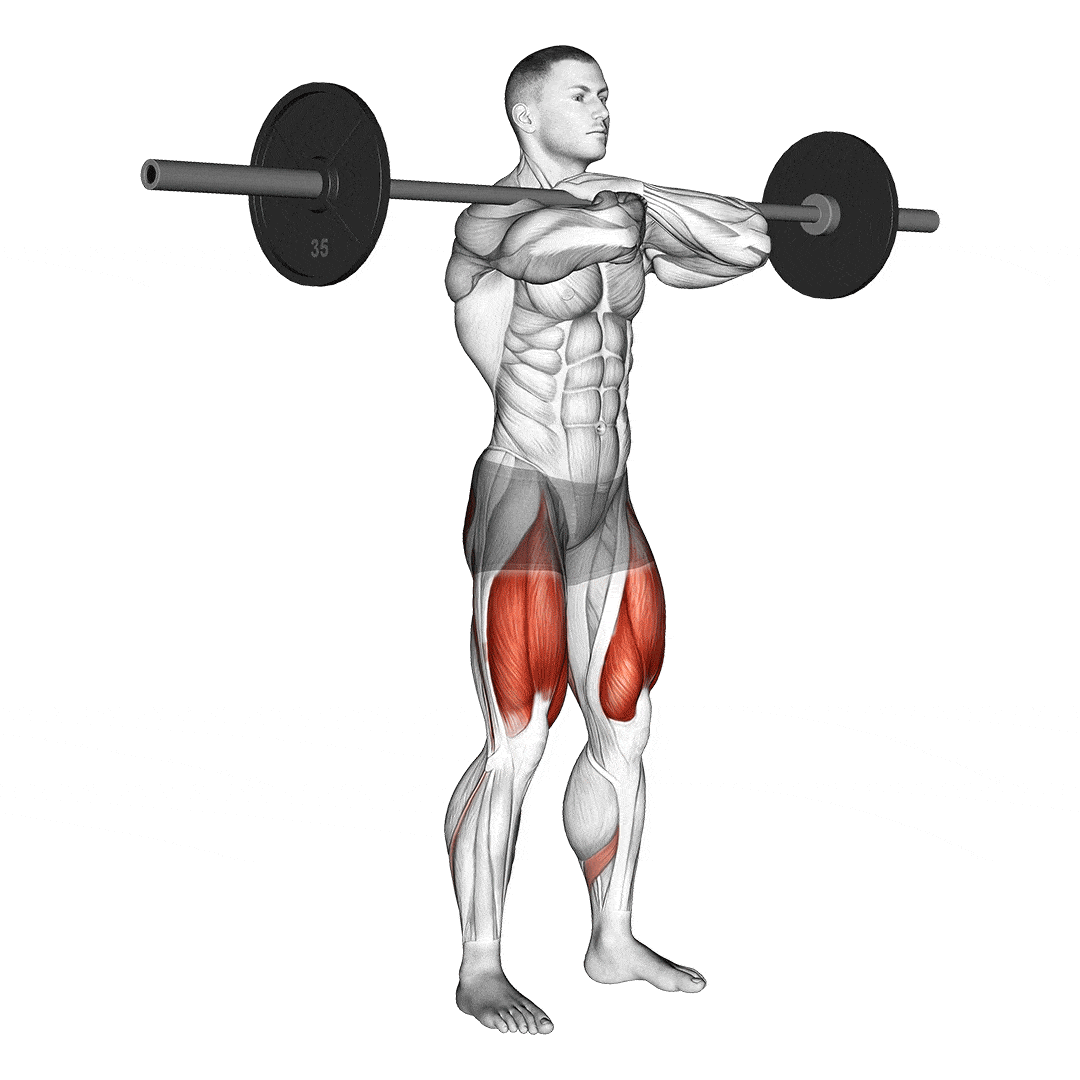
How to do it:
- Rack and hold a barbell across the front of your shoulders. Stand with your feet roughly hip-width apart.
- Push your hips back, bend your knees, and squat down as deeply as you can. Keep your torso upright, look straight ahead, and don’t drop your arms.
- Stand back up and repeat.
- Increase quad activation by putting your heels on a 1 to 2-inch block or weight plates.
Benefits:
- A compound exercise that also works your hamstrings and glutes
- Less lower back strain than barbell back squats
- Good for building muscle mass and strength
- Easier to dump the bar if you get into trouble and are unable to complete a rep
Coach’s Tip: Ensure your elbows are pointing straight ahead and not drooping downward during the movement. This helps to keep the barbell in place and maintains an upright torso, reducing the stress on the lower back.
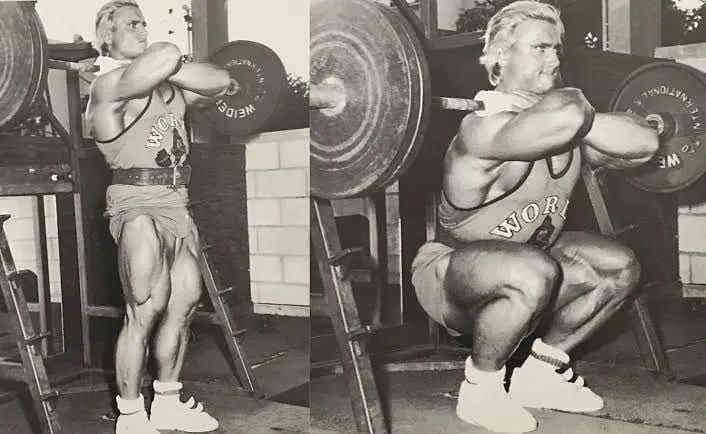
2. Hack squat machine
The hack squat machine is a very quad-centric exercise. Unlike leg presses, there is very little hamstring involvement in this exercise, especially if you adopt a narrow stance.
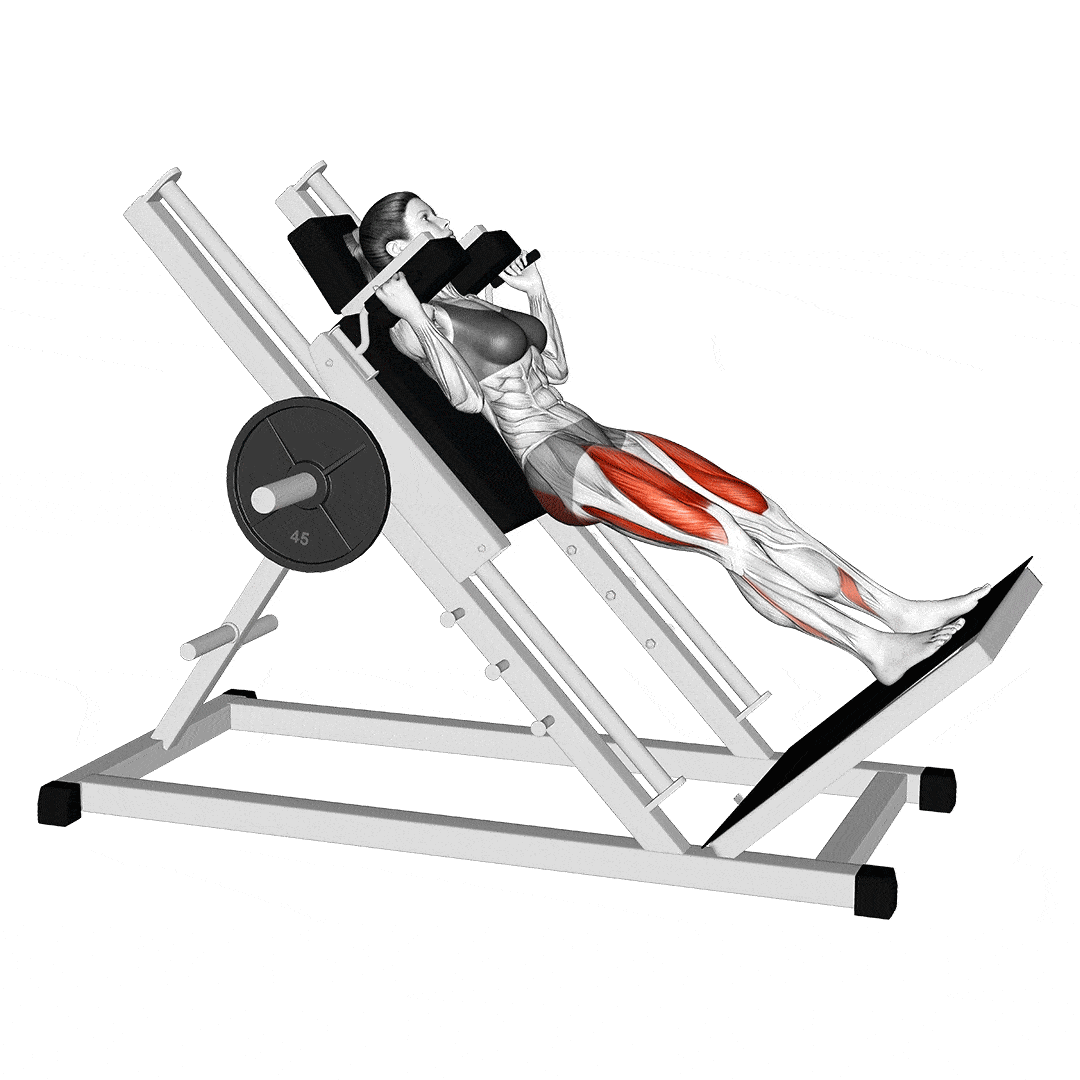
How to do it:
- Stand on the footplate with your feet about hip-width apart. Keep your feet low on the platform to maximize quadriceps recruitment.
- With your shoulders under the pads, bend your knees and squat down as far as you can without lifting your heels off the footplate.
- Stand back up and repeat.
Benefits:
- Easy to learn
- Minimal lower back stress
- Easy to adjust your foot position for greater comfort
- You can train to failure in relative safety on this exercise
Coach’s Tip: Keep your feet shoulder-width apart and do not lock your knees at the top of the movement. Maintaining a slight bend in the knees will keep tension on the quadriceps and protect the knee joints.
3. Leg extensions
No exercise isolates your quads like leg extensions. With no movement at your hip, this exercise really hammers the three Vastus muscles, and especially Vastus Medialis, which is especially active during the last few degrees of knee extension. Do this exercise slowly and deliberately, squeezing your legs straight at the mid-point of each rep. And yes, that burning you can feel in your quads is normal!
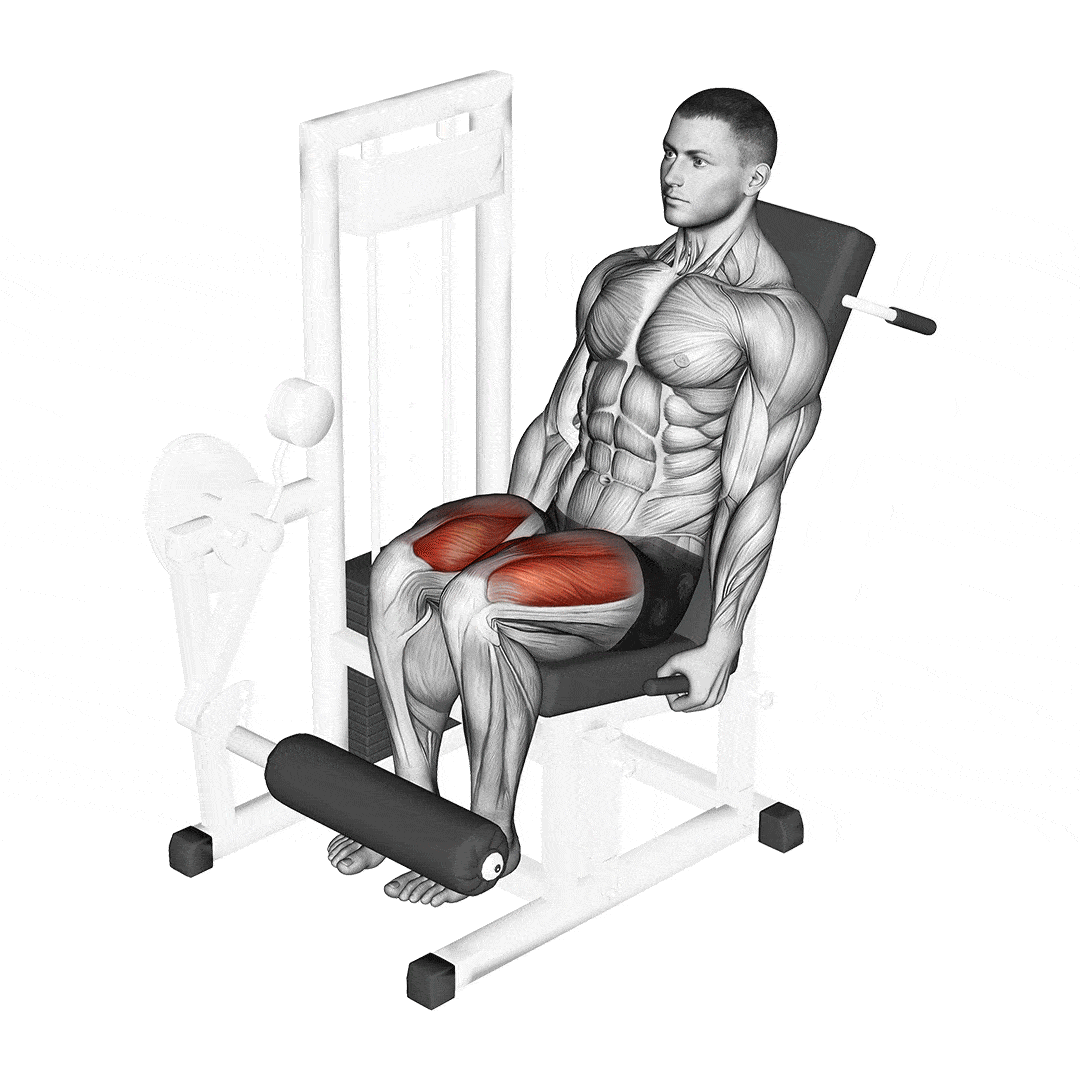
How to do it:
- 1. Adjust the backrest so that, when you sit on the machine, your knees line up with the lever arm pivot point. Place your feet behind the roller pad, so it’s just above your ankles.
- Straighten your legs, making sure you achieve full knee extension. Pause for 1-2 seconds with your legs straight.
- Bend your legs and lower the weight back down, but do not let it touch the rest of the stack. That would give you a rest between reps, making this exercise less productive.
Benefits:
- No strain on your lower back
- The only way to completely isolate your quads
- Can be done one leg at a time to fix left-to-right strength imbalances
- Very good for muscle growth and endurance
Coach’s Tip: Focus on controlled movement, especially during the eccentric (lowering) phase. Avoid using momentum and ensure that your knees are aligned with your toes throughout the exercise to avoid unnecessary stress on the knee joint.
4. Trap bar deadlifts from a deficit
Deadlifts are usually thought of as a posterior chain exercise that works your glutes, hamstrings, and back. While that is true of regular barbell deadlifts, trap bar deadlifts are much more quad-focused. Adding a deficit makes them even better for your quadriceps.
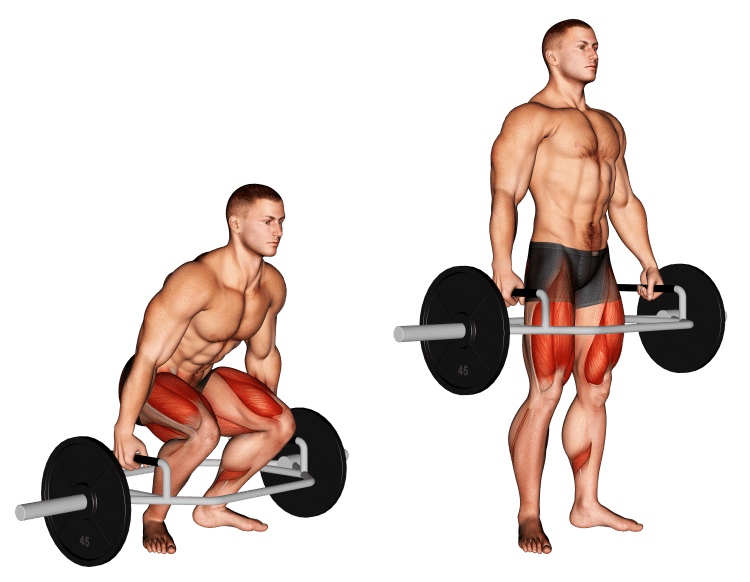
How to do it:
- Stand on a 3 to 6-inch platform inside your trap bar. You can use a 45-pound bumper plate, an aerobics step, or any other sturdy platform.
- Squat down and grab the handles of the trap bar. Drop your hips, lift your chest, brace your abs, and straighten your arms. Look straight ahead.
- Drive your feet into the floor and stand up. Do not lean back at the top as doing so puts a lot of strain on your lower back.
- Bend your legs and lower the weight back to the floor, reset your start position, and then repeat.
Benefits:
- No need to use a squat rack
- A great grip exercise
- Builds core strength
- Can be used to build muscle size and strength
Coach’s Tip: Engage your core and maintain a neutral spine throughout the lift. Ensure that your hips and chest rise at the same rate during the initial phase of the lift to avoid straining the lower back.
5. 1 ½ rep prisoner squats
While most of the best quad exercises involve equipment, some bodyweight exercises can be just as effective. This simple but tough exercise will leave your quads burning, but, conveniently, you don’t need to go to the gym to do them.
How to do it:
- Stand with your feet between shoulder and hip-width apart. Clasp your hands behind your head and push your elbows back to open your chest.
- Push your hips back, bend your knees, and squat down as far as you can without rounding your lower back.
- Stand up, but only rise halfway.
- Descend all the way back down and then stand fully upright. That’s one rep – keep going!
- Raise your heels 2-4 inches to increase quad activation.
Benefits:
- Do this exercise anywhere – even at home
- Ideal for beginners
- Easy to learn
- Very little lower back strain
Coach’s Tip: During the half-rep portion, ensure you’re maintaining tension in your leg muscles and not bouncing or using momentum. This will enhance muscle engagement and improve stability.
6. Barbell hack squat
The barbell hack squat is named after old-school bodybuilder and wrestler George Hackenschmidt, who was famed for his quad development. This golden-era exercise is not easy to master, but it will give your quads a unique workout.
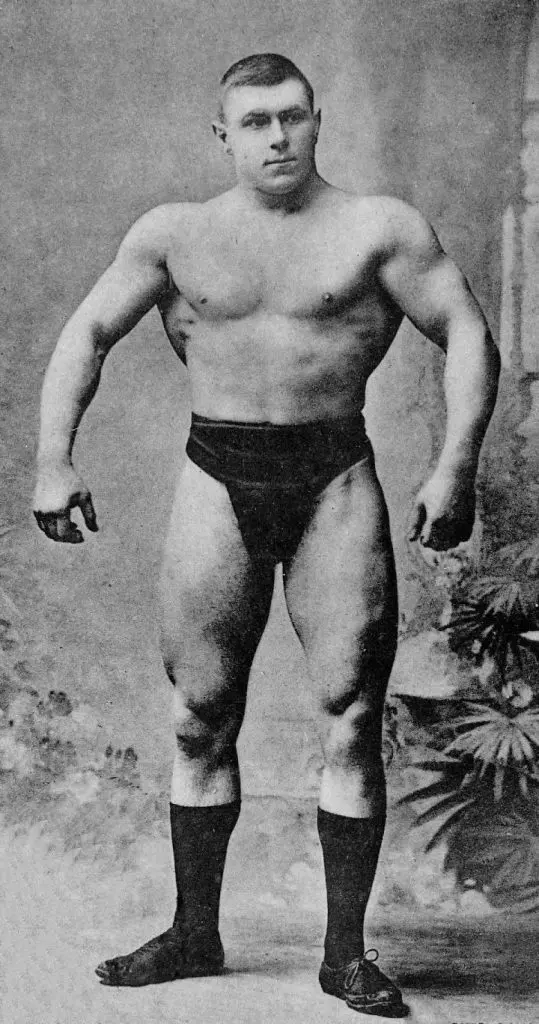
How to do it:
- Stand with your back to a loaded barbell. Your feet should be roughly shoulder to hip-width apart. Squat down and grab the barbell, so your palms are facing backward. Straighten your arms and brace your abs. Do not round your lower back.
- Extend your legs and stand up straight.
- Bend your legs and lower the weight back to the floor.
- Raise your heels to make this exercise even more quad-centric.
Benefits:
- No squat rack required
- Suitable for home exercisers
- Builds grip strength
- You can train to failure in relative safety on this exercise
Coach’s Tip: Keep the bar as close to your legs as possible throughout the movement to maintain balance and ensure the load is distributed evenly through your feet, not just the toes.
7. Bulgarian split squats
Most leg exercises work both legs at the same time. This makes a certain amount of sense because that allows you to lift more weight, and that’s important for building maximum muscle strength and size. However, always doing two-legged exercises can lead to left-to-right straight and muscle size imbalances. This quad exercise works one leg at a time so you can avoid or fix this problem.
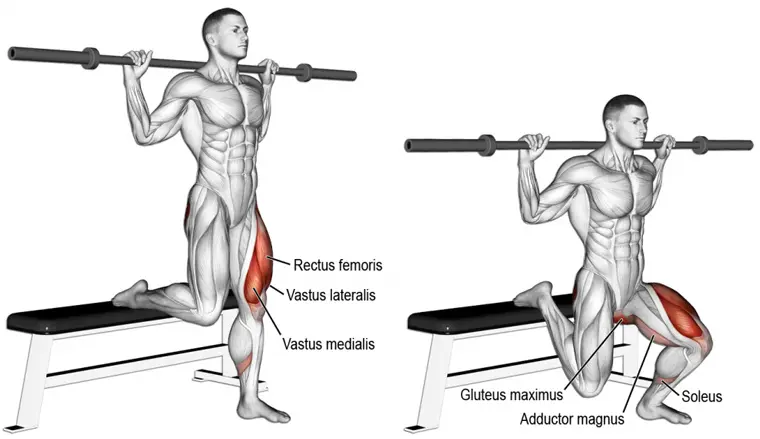
How to do it:
- Stand with your back to a knee-high bench. Bend one leg and place the top of your foot on the bench behind. Hop forward and into a split stance.
- Bend your legs and lower your rearmost knee to within 1-2 inches of the floor. Keep your body upright.
- Stand back up and repeat.
- Hold dumbbells in your hands to make this exercise harder.
Benefits:
- Good for hip mobility
- Helps improve balance
- A good exercise for improved sports performance
Coach’s Tip: Keep your torso upright and ensure your front knee does not go past your toes as you lower down. Engage your glutes and press through the heel of the front foot as you return to the starting position.
8. Leg presses
Leg presses allow you to work your legs to failure in relative safety. The back support protects your back, and you can just flip the safety catchers across to take the weight if you can’t complete a rep. This is an ideal exercise for going hard and heavy – even if you train on your own.
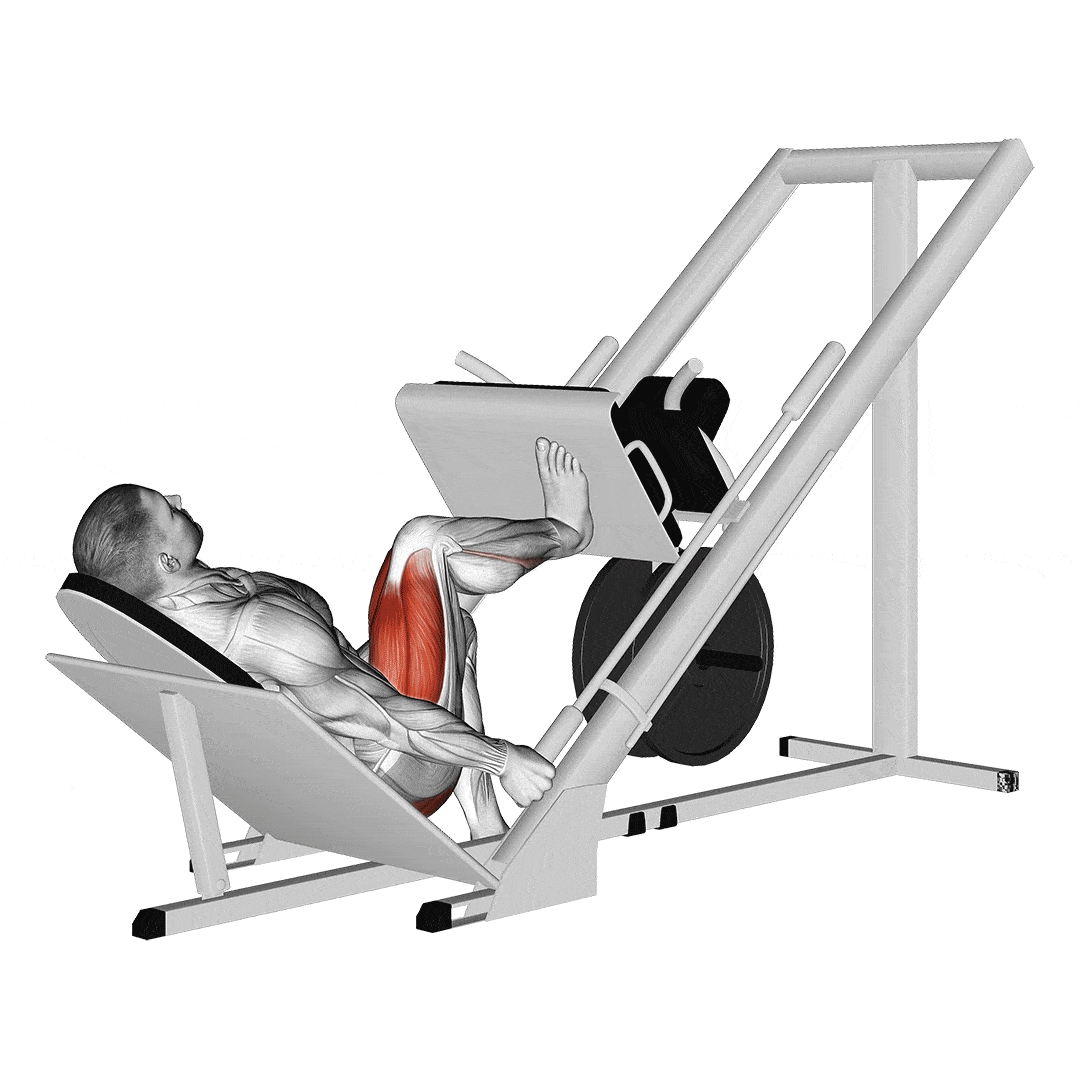
How to do it:
- Sit on the leg press machine and place your feet on the footrest, roughly hip-width apart. Move your feet down the footrest to emphasize your quads. A narrower stance will help too.
- Driving through your heels, press the weight up until your knees are straight.
- Lower the weight as far as you can without rounding your lower back and repeat.
Benefits:
- Easy to learn
- No need for spotters
- Suitable for building muscle size and strength
- A good quad exercise for beginners
Coach’s Tip: Position your feet so that they are in line with your knees and do not allow your knees to cave inward during the movement. Ensure a full range of motion without lifting your hips off the seat.
Level Up Your Fitness: Join our 💪 strong community in Fitness Volt Newsletter. Get daily inspiration, expert-backed workouts, nutrition tips, the latest in strength sports, and the support you need to reach your goals. Subscribe for free!
9. Goblet squats
While barbell front squats are one of the best quad builders you can do, they are also hard to master. The front rack position takes practice, and a lot of exercisers find it really uncomfortable. Goblet squats provide a similar quad workout but are much easier to learn. They’re more comfortable too!
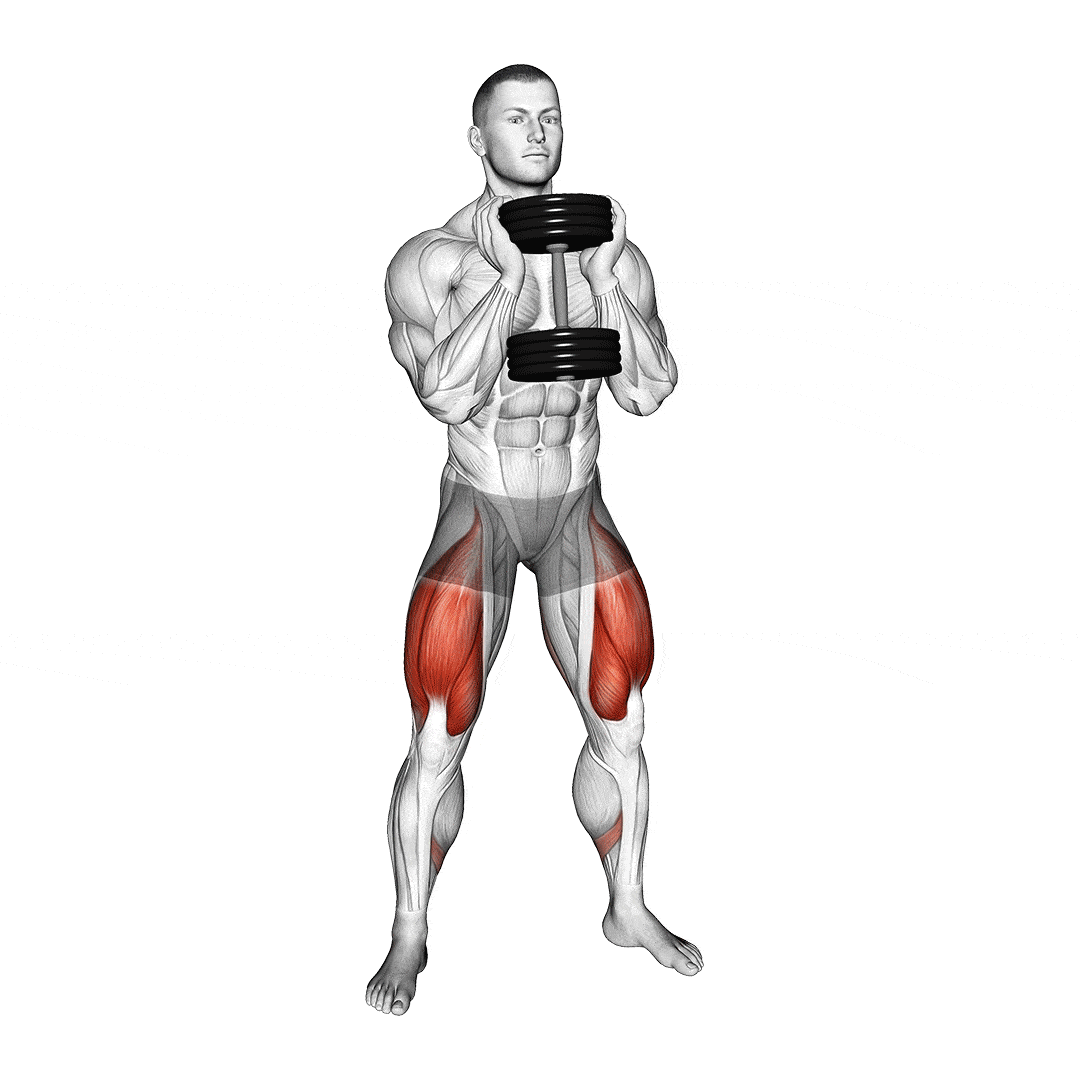
How to do it:
- Hold a kettlebell by the vertical handles, so it’s touching your chest. Tuck your elbows into your sides. Stand with your feet between shoulder and hip-width apart. Brace your abs.
- Bend your legs and squat down as far as you can without rounding your lower back.
- Stand back up and repeat.
- Raise your heels on weight plates or blocks to increase quad activation.
Benefits:
- No squat rack required
- You can train to failure in relative safety on this exercise
- A good core and posture exercise
Coach’s Tip: Hold the weight close to your chest and ensure your elbows are pointed downward. As you squat, keep your knees in line with your toes and push your hips back to engage the glutes and protect the knees.
10. Forward lunges
Lunges are a hugely underappreciated exercise. That’s a shame because they are an excellent quad builder, as well as being good for your glutes and hamstrings too. You can do them with just bodyweight, or with dumbbells or a barbell. Like Bulgarian split squats, they are useful for preventing and fixing left to right size and strength imbalances.
How to do it:
- Stand with your feet together, hands by your sides.
- Take a large step forward, bend your legs, and lower your rearmost knee to within 1-2 inches of the floor. Keep your torso upright.
- Push forcefully off your front leg to return to the starting position.
- Do all your reps on one leg before resting and then swapping sides.
- Experiment with the length of your lunge to get the best effect on your quads. For most people, a shorter step means more quads activation.
Benefits:
- Very low risk of back strain
- Suitable for building muscle mass and endurance
- Easy to learn
- Can be done almost anywhere
- Good for developing balance
Coach’s Tip: Take a big step forward to ensure your front knee does not go past your toes. Keep your torso upright and engage your core to maintain stability throughout the movement.
Quadriceps Anatomy
Quadriceps, or quads for short, is the collective term for the muscles on the front of your thighs. It’s sometimes called the quadriceps femoris, which means four-headed thigh muscle. The primary function of the quadriceps is knee extension, i.e., straightening your knees. The four muscles that make up the quadriceps are (1):
Rectus femoris: This is the largest of the quad muscles. It’s also the only one that crosses both the hip and the knee joints, making it a biaxial muscle. Because of this, it not only extends the knee joint but due to its function alongside the hip flexors, it also bends the hip.
Vastus Lateralis: Located on the outside of the thigh, this quadricep contributes to the width of your upper leg. It is a uniaxial muscle, which means it only crosses one joint. Because it does not cross your hip, its only function is knee extension.
Vastus Medialis: Vastus medialis is the teardrop-shaped muscle just above your knee. Like the other muscles, it is responsible for knee extension. It also helps make sure your patella or kneecap tracks and moves properly.
Vastus Intermedius: Located between and beneath vastus lateralis and vastus medialis, this muscle is not easy to see but, when well developed, contributes a lot to the size of your thigh.
Despite having four different origin points, the four quadriceps muscles come together to form the single quadriceps tendon and then the patellar ligament.
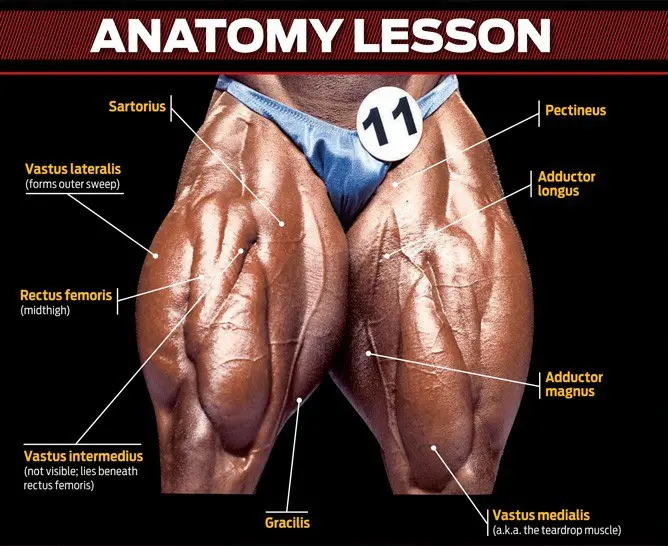
Important Quad Training Tips
Get the most from your quad-building workouts with these useful hacks and tips.
1. Always warm-up before your workout
A good workout starts with a proper warm-up. This is especially important for quad training because all of the best exercises heavily involve your knees, and sore knees are a common problem for bodybuilders.
Start your quad workout with a few minutes of light cardio, followed with some dynamic lower body stretches. Finally, do a couple of light sets of the exercises in your workout to fully prepare your muscles and joints and also practice the techniques you are about to use.
2. Raise your heels with caution
A lot of leg exercises are more quad-centric if you raise your heels, either putting them on weight plates or wooden blocks. However, while this is an effective muscle-building strategy, it also increases the stress on your knees. Raising your heels tends to shift your weight onto your toes and pushes your shins forward of vertical. This does increase quad activation, but it increases knee wear and tear too. Keep your heels flat on the floor if you have a history of knee pain.
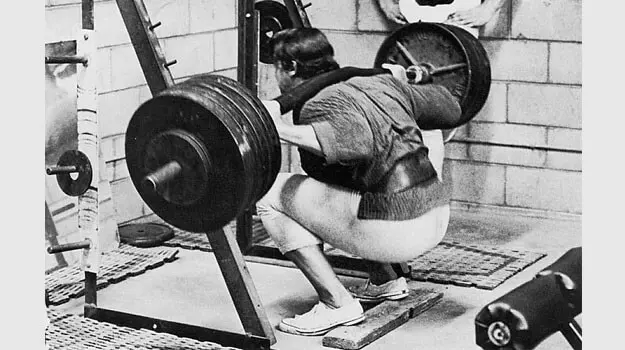
3. Keep your joints warm with neoprene knee sleeves
Even healthy knees can ache during quad training. Neoprene knee sleeves provide support and warmth to keep your knees feeling comfortable, stable, and free from pain. Elasticated knee wraps, which are often used by powerlifters, are not recommended. They provide extra bounce out of the bottom of things like squats and leg presses. They allow you to lift more weight, but only by doing some of the work for you. Knee wraps are useful for powerlifters but are much less so for bodybuilders.
4. Use a variety of quad building exercises
Out of all the exercises we’ve listed, some are probably already your favorites, while there are others you may not have done before. To keep your workouts fresh and interesting, you mustn’t just do the exercises you like. It’s been proven that variety is a crucial favor for developing strength and muscle mass, as well as boosting training motivation (2). Make sure you do some of the lesser-known exercises as well as the ones that you are more familiar with.
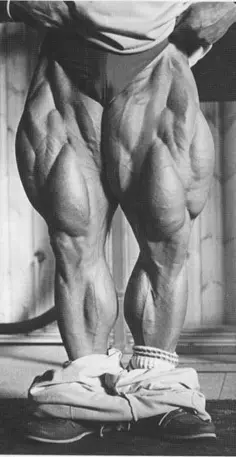
5. Adjust your reps and weight to match your training goals
Get the most from your quad-building workouts by following these weight and rep guidelines.
- For strength: 1-5 reps with 85-100% of your one-repetition maximum (1RM)
- For muscle hypertrophy: 6-12 reps with 67-85% of your 1RM
- For muscular endurance: 13-20+ reps with 50-67% of your 1RM
Frequently Asked Questions
Do you have any questions? We’ve got the answers! If you can’t find the answer you want below, drop us a line in the comments section, and we’ll get back to you as soon as we can.
How often should I train my quads?
I think you should train your legs twice a week but train your quads during one session and your hamstrings in the second. That way, you can give both of these important muscle groups the attention they deserve. For example, train your quads on Monday, and your hamstrings on Thursday.
Are squats bad for your knees?
Some people – even doctors – think that squats are bad for the knees, but this isn’t true. While squatting with improper technique could lead to injury, done right, squats should actually strengthen your knees. If squats cause you pain, make sure you are doing them correctly. Also, consider using less weight and lifting with a slower tempo. This strategy takes stress off your joints while making sure there is still enough muscle-building tension.
What should I wear for quad training?
In a lot of cases, the best shoes for quad training are Olympic weightlifting shoes. They have a solid, slightly raised heel, and won’t compress under heavy loads. They are also very hardwearing and provide lots of support.
Another good choice is minimalist athletic shoes such as Chuck Taylors. With minimal cushioning, they won’t distort or collapse under heavyweights.
The one type of shoe we don’t recommend is running shoes. Running shoes are designed to be shock absorbent, and that means they will distort and compress when loaded. The last thing you need when squatting or leg pressing heavyweights is for your shoes to collapse.
If you are serious about quad training, you will really notice the difference when you wear Olympic weightlifting shoes. Otherwise, just ditch your running shoes and wear a pair of flat, un-cushioned sneakers instead.
How many quad exercises should I include in my workouts?
This is a tricky question to answer because we don’t know how experienced you are. Some lifters do just 1-2 exercises for their quads, but then they do 4-5 sets of each one. Others prefer to do more exercises but fewer sets. Some do lots of exercises AND lots of sets!
You’ll need to experiment to discover the answer to this question yourself. Do as many exercises as it takes to get results, but not so many that you are unable to recover from your workouts. Your best bet is to start low and increase gradually after that, monitoring your performance and recovery as you go.
The Wrap-up
Big quads will really set you apart from other gym-goers. While you may never build thighs like Tom Platz, who had arguably the best quads in the history of bodybuilding, you should still be able to develop legs you can be proud of. It won’t be easy, and you’ll have to pay your dues in sweat and even tears in the gym.
But, if you commit to using the best quad exercises, you too can build head-turning, show-stopping, awe-inspiring legs.
References:
- Encyclopedia Britannica: Quadriceps Femoris Muscle https://www.britannica.com
- PubMed: Baz-Valle, Eneko; Schoenfeld, Brad J.; Torres-Unda, Jon; Santos-Concejero, Jordan; Balsalobre-Fernández, Carlos (2019). “The effects of exercise variation in muscle thickness, maximal strength and motivation in resistance trained men”. PloS One. 14 (12): e0226989. doi:10.1371/journal.pone.0226989. ISSN 1932-6203. PMC 6934277. PMID 31881066. https://www.ncbi.nlm.nih.gov


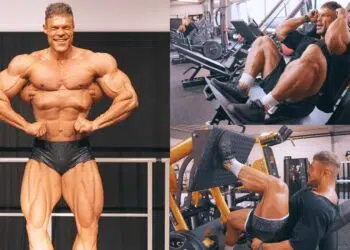
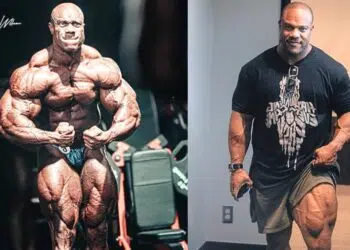
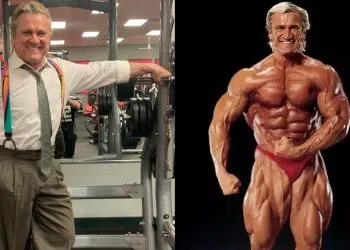
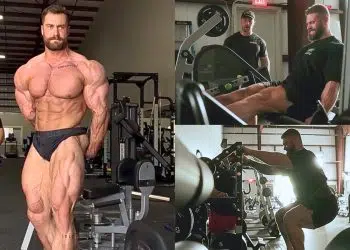
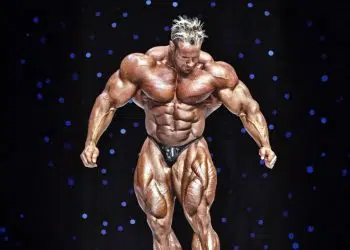
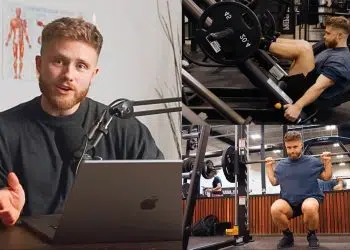




Hey Patrick thanks for the info. My question may be a tough one for you to answer. How heavy can I squat or leg press with my full hip replacement – 2 yrs ago?
Recent past history::
Lost 45 lbs (& a lot of muscle )5 yrs ago going through chemo & radiation treatments. Hip damage probably from years of playing basketball and the muscle lost brought the pain to the forefront. Other hip has little padding left.
Hey David,
I’m no medical expert so I’m loath to tell you how much weight a replacement hip can support. I imagine they’re pretty strong, as they have to support your bodyweight. But, beyond that I can’t say. I know I managed to break a titanium plate on my collar bone while lifting, so these things aren’t indestructible.
My best advice is to start light and increase the load gradually. Remember that even lighter weights can build strength if you push your muscles close to failure. However, I’d be very cautious about working too hard in case you damage your replacement. Also, take care not to flex your hip too far, as I don’t know how stable a replacement hip joint is. The last thing you need is your hip dislocating mid-set!
I’m a massive fan of isometrics for people with joint issues, as they allow you to tax the muscles without overloading your joints. You could also consider doing super slow reps, which make light weights feel much heavier. This is another joint-saving strategy. The leg press may not even be your best option. You can train your lower body with a combination of leg extensions, leg curls, and glute extensions. No squats or leg presses required.
Finally, consider speaking to the surgeon who did the procedure to see what they suggest. There maybe specific recommendations re. the weight capacity of a replacement hip joint.
I hope that’s a little helpful. Please let me know if I can provide any more info.
Good luck and I I wish you all the best wit your training!
This may also be of interest – it’s about squats, but covers much of the same info you’d need to consider for leg presses.
https://barbellrehab.com/squatting-after-hip-replacement/